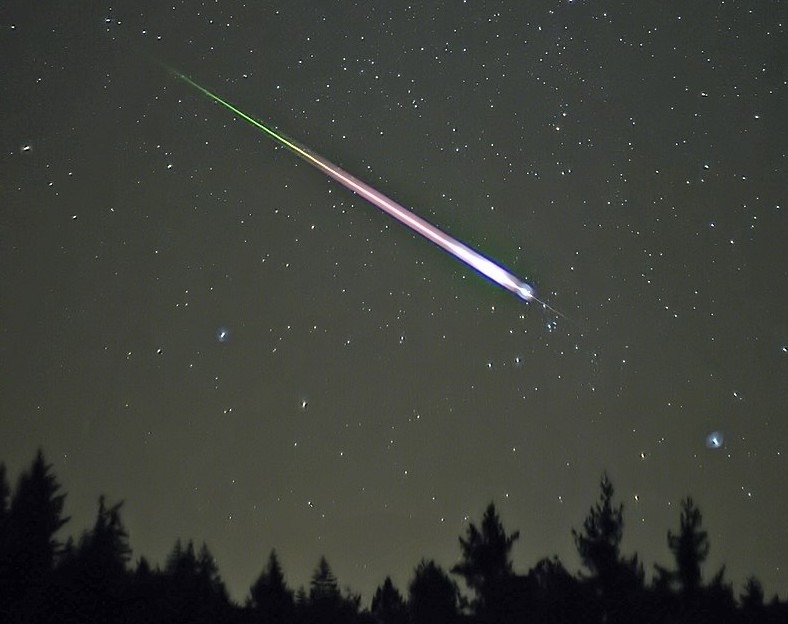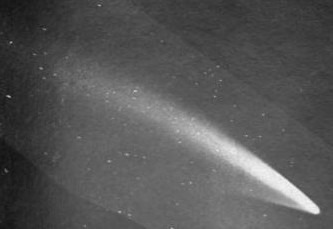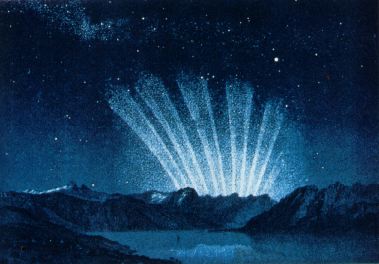Why Are Icy Moons Unique in Our Solar System?
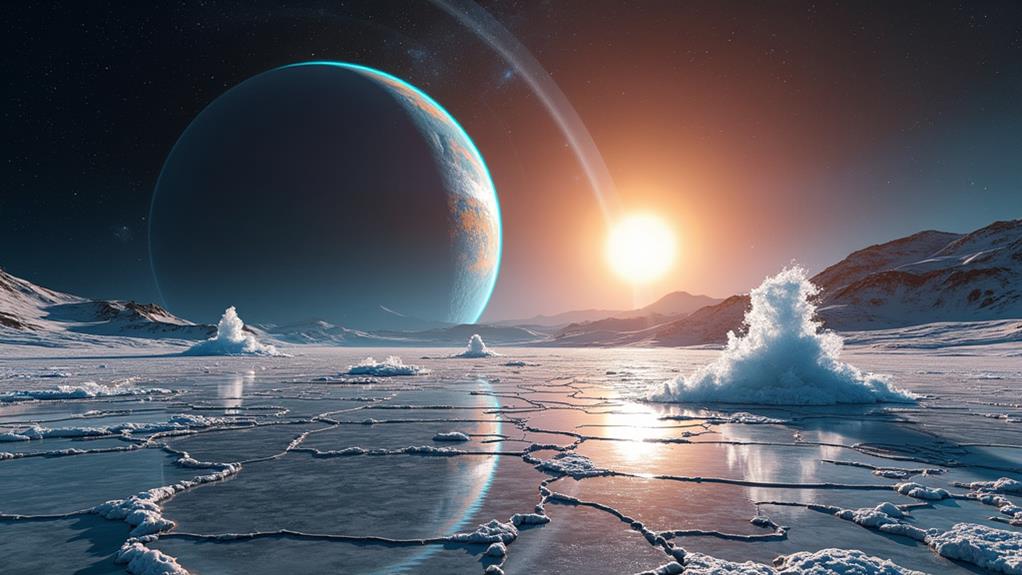
Icy moons like Europa, Enceladus, and Ganymede are fascinating because they form beyond the frost line, accumulating thick ice layers and potentially harboring subsurface oceans. You'll find unique geological activities such as cryovolcanism and tectonic shifts driven by tidal flexing from their giant planet hosts. These moons also display complex surface compositions with signs of organic molecules and water vapor plumes. Their potential to support life makes them prime targets for future space missions. To uncover more about their intriguing characteristics and the mysteries they hold, there's plenty to investigate.
Key Takeaways
- Icy moons form beyond the frost line, accumulating ice and unique compositions not found in warmer inner regions.
- Subsurface oceans on moons like Europa and Enceladus may contain more water than all Earth's oceans combined.
- Geological activity, such as cryovolcanism, indicates dynamic internal processes and surface renewal on icy moons.
- Potential for life exists due to conditions like hydrothermal activity and the presence of organic molecules in subsurface oceans.
- Space missions, such as Europa Clipper and JUICE, aim to investigate habitability and surface characteristics of icy moons.
Formation and Origins
Have you ever wondered how icy moons in our solar system came to be? These fascinating celestial bodies primarily form in the colder, outer regions beyond the frost line, where temperatures allow for ice and volatile compounds to accumulate. Icy moons orbiting gas giants like Jupiter and Saturn are believed to have formed from the remnants of the solar nebula through accretion processes, similar to planet formation.
In the outer solar system, the conditions are perfect for the creation of these icy moons. Unlike the warmer inner regions, the outer reaches allow for significant ice accumulation. This is why the icy satellites of gas giants didn't form in the warmer inner proto-satellite disk regions. Instead, they developed in the colder outskirts, leading to their unique icy compositions.
Some moons, such as Charon and Dysnomia, which orbit dwarf planets, formed differently. They originated from large impacts that ejected material into space, which then coalesced to form these smaller bodies. Typically, icy moons have rocky cores surrounded by thick layers of ice, a structure that influences their geological activity and potential habitability, making them intriguing subjects for exploration.
Orbital Characteristics
The orbital characteristics of icy moons are as fascinating as their formations. These moons, like Europa, largely orbit giant planets beyond our Solar System's frost line, where ice can remain stable. Europa, Ganymede, and Callisto, orbiting Jupiter, exemplify this. Each moon's orbital path provides clues to its unique environment and history.
Europa's orbit is particularly intriguing due to its proximity to Jupiter and its interaction with the planet's strong gravitational field. This causes tidal flexing, generating internal heat and maintaining its subsurface ocean. The outer Galilean moons, like Callisto, contain more ice than the inner moons, reflecting the colder conditions further from Jupiter.
Saturn's moon Titan showcases another fascinating orbital scenario. Titan's thick atmosphere and icy surface are directly tied to its distance from Saturn and the Sun. Unlike the inner warmer regions, these icy moons couldn't have formed there due to the heat, which would have prevented ice from remaining solid.
Dwarf planet moons, such as Charon orbiting Pluto, formed from significant impacts, influencing their orbital stability. These events created moons with distinct and often eccentric orbits, showcasing the diverse and dynamic processes shaping our Solar System's icy satellites.
Surface Composition
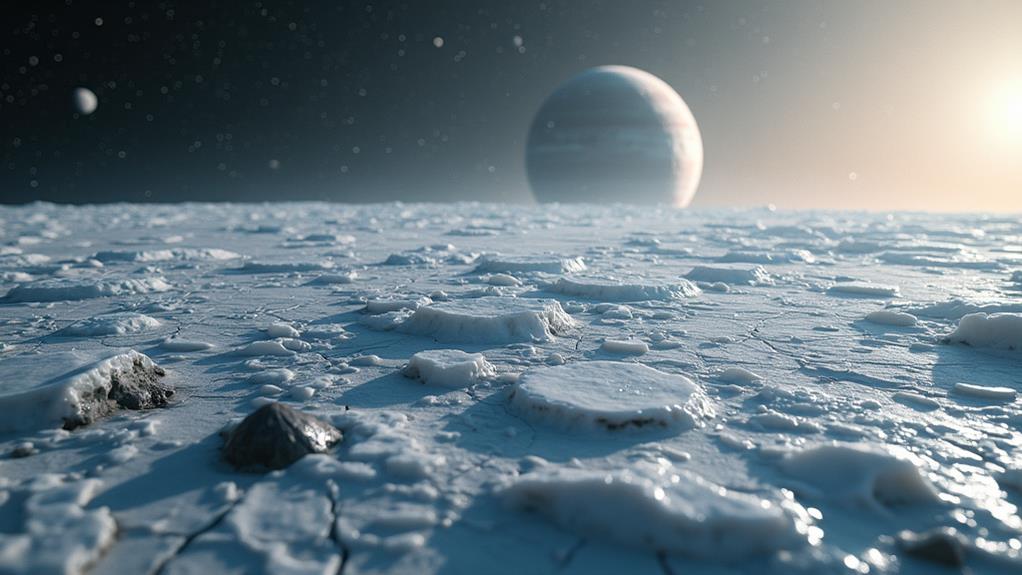
Exploring the surface composition of icy moons reveals a captivating array of materials and processes. On Jupiter's moon Europa, the icy crust is a mix of substantial ice and water, making up about 8% of its mass. This ice interacts with salts and organic molecules, hinting at complex chemistry. Meanwhile, Saturn's moon Enceladus showcases an icy crust primarily composed of water ice. This composition feeds the moon's iconic plumes of vapor that erupt from its surface, indicating dynamic geological activity.
Ganymede and Callisto, Jupiter's outer Galilean moons, also exhibit higher ice content compared to their inner counterpart, Io. Callisto even displays visible frost deposits, a clear sign of water ice and ongoing surface processes. Mimas, with its remarkably low density of 1.1 g/cm³, underscores its largely icy and porous nature, further illustrating the diversity in ice composition among these moons.
This diverse and rich surface composition, combined with geological activity, makes these icy moons intriguing. They point to a history of interactions and processes that could support subsurface oceans, heightening their potential for habitability and making them unique in our solar system.
Subsurface Oceans
Beneath the icy crusts of moons like Europa and Enceladus, scientists believe vast subsurface oceans exist, potentially holding more water than all of Earth's oceans combined. These oceans are hidden beneath thick ice shells but contain liquid water, making them intriguing candidates in the search for life beyond Earth.
Europa, for instance, has a subsurface ocean that may be teeming with as much, if not more, water than our planet's oceans. Enceladus, another icy moon, has a global ocean beneath its icy surface, evidenced by the spectacular plumes of water vapor that regularly shoot out from its southern pole. Even Ganymede, the largest moon in our Solar System, is thought to have a subsurface ocean, although it remains less studied compared to Europa and Enceladus.
Why are these subsurface oceans so fascinating?
- Potential for Life: These oceans might harbor microbial life, thanks to hydrothermal activity that could provide necessary energy.
- Temperature: Subsurface ocean temperatures around 30°F (-1.1°C) suggest conditions where life could potentially exist.
- Water Availability: These moons might contain more liquid water than Earth.
- Exploration Targets: These environments are prime targets for future missions aimed at finding life beyond Earth.
Geological Activity
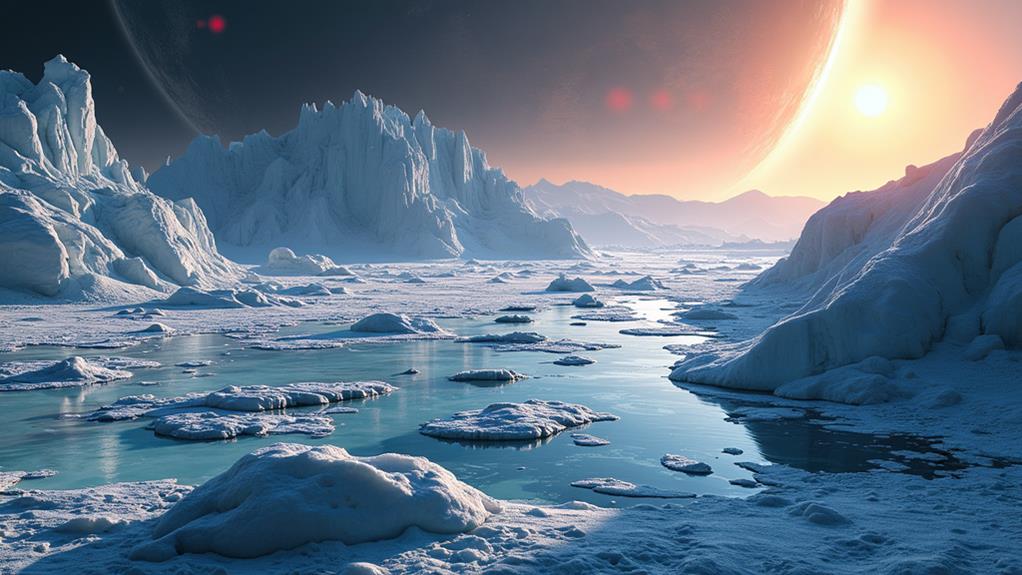
Geological activity on icy moons is nothing short of captivating, revealing dynamic processes beneath their frozen surfaces. Unlike the geologically inactive worlds scientists once imagined, these moons exhibit lively geological activity driven by internal heat. This heat allows for continuous surface renewal, evidenced by the unexpected lack of impact craters on moons like Ganymede and Enceladus. These smooth surfaces suggest ongoing geological processes that keep invigorating their appearance.
Cryovolcanism, a standout feature of icy moons, further showcases their dynamic nature. For instance, Europa's cryovolcanic eruptions hint at the presence of a liquid ocean beneath its icy crust. When these subsurface oceans erupt to the surface, they create dramatic plumes and reshape the landscape, adding to the complexity of these environments.
Voyager missions were fundamental in reshaping our understanding of icy moons, revealing diverse terrains and active geological features. From tectonic activity to the presence of plumes, these moons are anything but static. The geological activity you observe on these moons underscores their uniqueness and highlights the intricate and dynamic processes operating far beyond Earth, offering a glimpse into the mysteries of our solar system.
Potential for Life
Among the many wonders of our solar system, icy moons like Europa and Enceladus stand out for their potential to harbor life. These moons are fascinating because they possess conditions that could support life as understood. Europa, one of Jupiter's moons, boasts a subsurface ocean that's estimated to be twice the size of all Earth's oceans combined. This vast ocean increases the likelihood of uncovering life, especially since its conditions might allow interactions between water and the rocky mantle below.
Enceladus, another icy moon, harbors subsurface oceans as well. It has been observed ejecting plumes of water vapor containing complex organic compounds. These plumes suggest that life-supporting conditions might exist beneath its icy crust. Furthermore, the presence of molecular hydrogen in Enceladus' plumes indicates hydrothermal activity similar to Earth's oceanic hydrothermal vents, which are recognized to support diverse ecosystems.
Key points include:
- Subsurface oceans on Europa and Enceladus.
- Europa's ocean is twice the size of Earth's oceans.
- Enceladus ejects water vapor with organic compounds.
- Hydrothermal activity on Enceladus.
Both moons, along with Saturn's moon Titan, are prime targets for astrobiology research, with missions like NASA's Europa Clipper set to explore deeper into their mysteries.
Observational Discoveries
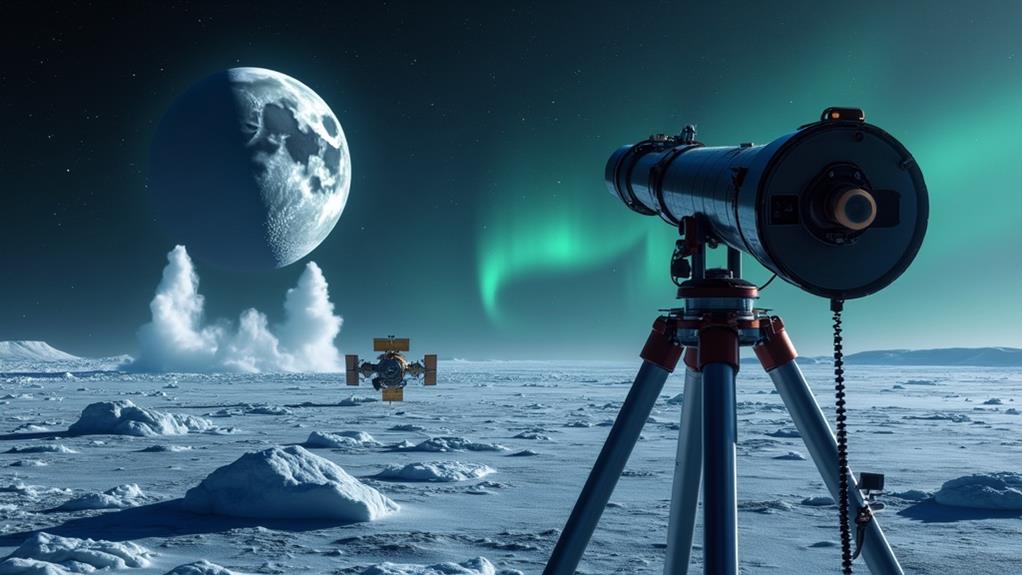
How did we initially reveal the secrets of our solar system's icy moons? It all began with the Voyager 1 mission in 1979. As it passed by moons like Europa and Ganymede, it captured detailed images showing their complex surface features and geological activity. These initial observations hinted at the fascinating mysteries beneath their icy crusts.
Later, the Galileo spacecraft provided more compelling evidence. It revealed that Europa likely harbors a subsurface liquid ocean, making it a prime candidate for potential habitability. Observations showed an icy exterior, but beneath it, there could be conditions suitable for life.
Cassini's flybys of Saturn's Enceladus added another layer of excitement. The spacecraft detected active plumes of water vapor, indicating a global ocean beneath its surface. This revelation pointed to significant geological activity and raised questions about the moon's potential for supporting life.
False-color images of Ganymede displayed varying surface compositions and geological features, suggesting a history of tectonic activity. More recently, observations confirmed water vapor plumes in Europa's atmosphere, strengthening its unique potential for life. Soon, NASA's Europa Clipper mission will further investigate these intriguing moons, aiming to reveal more secrets hidden beneath their icy crusts.
Space Missions
Building on decades of investigation, space missions like NASA's Europa Clipper and the European Space Agency's JUICE are poised to revolutionize our understanding of icy satellites. The Europa Clipper mission aims to conduct detailed surveys of Europa's surface and subsurface ocean, searching for signs of habitability and potential life. You'll find that this mission will focus on analyzing the chemical compositions of plumes and surface materials, enhancing our grasp of Europa's environment.
Similarly, the JUICE mission will examine the Galilean moons of Jupiter, including Ganymede and Callisto. Scheduled to launch in 2022, JUICE will assess these moons' potential for supporting life, with a particular interest in their subsurface oceans. Both missions will employ advanced scientific instruments to investigate the mysteries of these icy worlds.
Key points about these missions include:
- Europa Clipper: Focuses on Europa, analyzing its surface and ocean for signs of life.
- JUICE mission: Targets Ganymede and Callisto, evaluating their habitability.
- Advanced instruments: Used to study chemical compositions and surface materials.
- Future examination: Potential lander missions to directly sample subsurface oceans.
These missions promise to expand our knowledge and potentially uncover life-supporting conditions on these icy moons.
Scientific Research
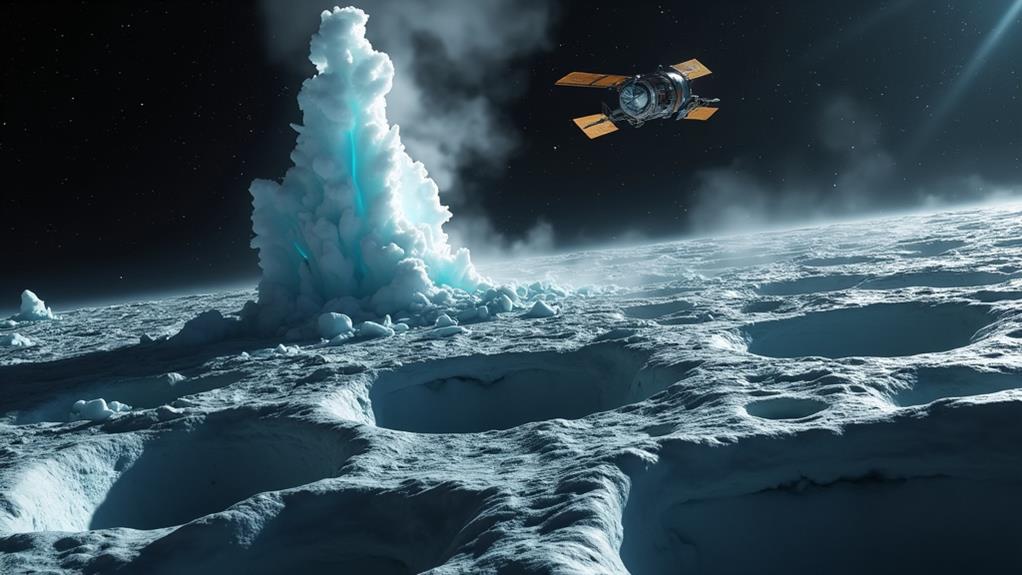
Scientific research into icy moons like Europa and Enceladus is uncovering fascinating insights that could reshape our understanding of life's potential beyond Earth. You'll find that these moons are particularly intriguing because of their subsurface oceans, hidden beneath thick layers of ice. NASA's Cassini spacecraft has already revealed complex organic molecules in the plumes of Enceladus, hinting at the potential habitability of these hidden waters.
The Europa Clipper mission, set to launch soon, aims to explore even deeper into the mysteries of Europa. It will gather detailed data on the ice shell's thickness, the chemical composition of the surface, and the characteristics of the subsurface ocean. This mission will be essential in evaluating if Europa could support life.
Moreover, ongoing studies focus on the unique geological processes observed on these moons. Factors like cryovolcanism, where icy moons erupt with water instead of molten rock, and tectonic activity challenge our previous assumptions about their geological inactivity. Understanding these processes is vital for grasping how they influence the potential habitability of subsurface oceans. So, as research progresses, we're getting closer to answering the timeless question: Are we alone in the universe?
Comparative Analysis
Delving into a comparative analysis of icy moons like Europa and Enceladus reveals their distinct yet fascinating characteristics that set them apart from other celestial bodies. These moons are notable for their thick ice shells covering subsurface oceans, which hint at the potential for habitability. Europa's subsurface ocean, estimated to be twice the volume of Earth's oceans, underscores the vast amounts of liquid water these moons might harbor. In contrast to the inactive surfaces of terrestrial planets, icy moons exhibit dynamic geological activity, including active plumes on Enceladus that eject water vapor and organic compounds.
Comparative analysis highlights several key points:
- Subsurface Oceans: Europa and Enceladus both host vast subsurface oceans beneath their ice shells.
- Geological Activity: Unlike rocky planets, icy moons show signs of cryovolcanism and tectonic activity.
- Active Plumes: Enceladus features active plumes that release water vapor and organics, suggesting internal heat sources.
- Potential Habitability: The presence of liquid water and organic compounds raises the possibility of life-supporting conditions.
Frequently Asked Questions
Why Are Icy Moons Important?
You should care about icy moons because they have habitable potential. With subsurface oceans, these moons might support life. Their geological activity, like cryovolcanism, shows they're dynamic places. Enceladus and Europa, for example, offer astrobiological significance due to water vapor plumes and organic compounds. Missions like NASA's Europa Clipper aim to investigate these fascinating features, highlighting their importance in the quest to understand extraterrestrial life.
What Is the Most Unique Moon in the Solar System?
When you consider the most unique moon in the solar system, it's a coincidence that Titan's atmosphere, Enceladus' geysers, Europa's ocean, and Ceres' surface all come into play. Each moon has extraordinary features, but Titan's dense atmosphere and lakes of methane and ethane make it stand out. It's unlike any other place, raising intriguing questions about alien life forms and alternative biochemistries. You can't help but be fascinated by its mysteries.
What Is the Most Important Reason Why an Icy Moon?
You might wonder why an icy moon is so significant. The most vital reason is its astrobiological potential. These moons have subsurface oceans, which could harbor life. Their geological activity, like Enceladus's active plumes, hints at dynamic environments. Plus, the surface composition of these moons provides fundamental clues about their history and the solar system's diversity. This makes them prime targets for scientific exploration.
Why Is the Moon Unique Among the Other Moons in the Solar System?
The Moon is unique because it's about 1/4 the diameter of Earth, a surprising statistic compared to other moons. Its formation from a giant impact with Earth sets it apart. Unlike many moons, it has significant geological activity, evidenced by its maria and highlands. Though lacking potential habitability, the Moon's distinct surface features and synchronous rotation, always showing the same face to Earth, make it truly unique in our Solar System.

